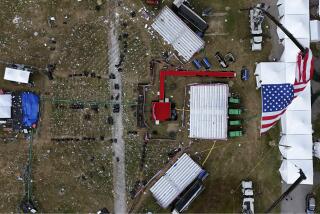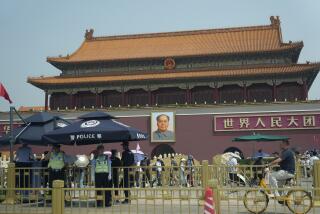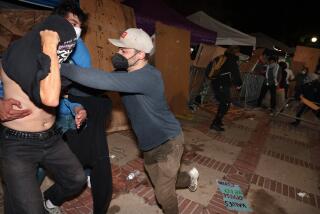Chengdu Quiet After Echoing Beijing Clash
CHENGDU, China ā While the world watched in horror as army troops and tanks brutally suppressed protesters around Beijingās Tian An Men Square on June 4, a similarly violent confrontation took place in this provincial capital, off camera and out of sight to all but a few Western observers.
The details may never be fully known, but what is certain is that thousands of Chengdu residents defied authorities by rushing to defend a student-led demonstration from an attack by police, and that some paid with their lives.
Eyewitnesses estimate that as many as 30 people were killed and 100 to 300 were injured when the police assaulted them with truncheons, bayonets and guns in an effort to secure the base of a huge statue of Chairman Mao Tse-tung in the cityās center. Pro-democracy demonstrators had been camping out peacefully around the statue for several weeks in a scaled-down version of the Tian An Men protest.
In the ensuing battle, an unruly crowd, propelled by hoodlums and unemployed youths, set fire to a sprawling market and a movie theater, ransacked vendorsā stalls and trashed two tourist hotels in nearly 48 hours of unrest.
Sign of Wide Opposition
Although the extent of the violence was overshadowed by the slaughter in Beijing, where hundreds and possibly thousands of protesters died, the incident in Chengdu was one confirmation that opposition to the hard-line regime of senior leader Deng Xiaoping was widespread and deeply rooted earlier this month.
Trouble also flared in other cities throughout China as the news of the Tian An Men massacre spread via long-distance telephone calls and the short-wave radio broadcasts of the Voice of America and the British Broadcasting Corp. Various incidents were reported in such urban centers as Shanghai, Xian, Lanzhou, Harbin and Nanjing. But Chengdu apparently saw the most intense conflict outside Beijing.
Ironically, Dengās birthplace is near here in the heart of Sichuan province, Chinaās most populous, known in the West for its hot and spicy cuisine. Landing by airplane at Chengdu airport, about 1,000 miles southwest of Beijing, a visitor sees an expanse of lush green fields that attest to Sichuanās status as the countryās prosperous grain belt.
Zhao Was Governor in 1970s
It was also here that disgraced Communist Party General Secretary Zhao Ziyang served as governor in the 1970s and introduced pioneering market-oriented reforms that allowed farmers to till their own land--and averted looming famine. The reforms here became a model for Chinaās economic reform program. Zhao, however, is believed to have been purged in a power struggle with Deng and other hard-liners in the days before the bloody crackdown.
Now, Chengdu has more or less returned to normal, but signs of the devastation of nearly two weeks ago remain. Burned-out buildings and brick rubble are spread across the city block where the Peopleās Market, a collection of more than a hundred stalls and shops, once stood. Across the street, the Peopleās Movie Theater is a scorched shell. Chengduās underground market, a converted bomb shelter housing private enterprise coffee shops and restaurants, is closed off. The silhouettes of big-character posters scraped and burned off the base of the towering Mao statue are still visible.
Truckloads of helmeted police toting rifles still patrol the city, sustaining an atmosphere of tension.
Yet all seems peaceful at Sichuan University, a key center of student activism. As has happened at universities in major cities, most students have gone home. The autonomous student union here has disbanded under pressure from authorities, and only graduating seniors remain on campus, along with a few stragglers from the junior classes. Student leaders are assumed to be in hiding.
āThe unrest is basically in the past,ā said a sophomore majoring in chemistry who went home during the troubles, but returned to school the other day to complete some laboratory experiments.
The oversized bulletin board by the administration building has been scraped clean of pro-democracy posters and in their place is a stern warning from school officials telling students to avoid the area around the Mao statue and to keep outsiders off campus. As if to underscore that caution, authorities arrested two British television journalists as they were filming an interview on campus earlier this week, confiscating their passports, film and camera equipment.
The two, reporters Vernon Mann and cameramen John Elphinstone of Independent Television News, were ordered Friday to leave the country within 24 hours. Authorities accused them of violating martial-law regulations
The chemistry major said many students are perplexed over what happened downtown on June 4-5. They have been told by the official media that only two students were killed, but they are skeptical. Officials have said that about 300 police officers were injured in the earlier violence.
āMost students donāt believe the news reports. They are just presenting the government line,ā he said. āPeople who have independent opinions donāt believe it.ā
Police Moved on Protesters
According to a foreign resident of Chengdu who saw much of the confrontation and gathered information from other reliable witnesses, the Peopleās Armed Police moved in on about 50 students at the base of the Mao statue--die-hard remnants of a dwindling sit-in and hunger strike--before dawn on Sunday, June 4.
By about 7:30 a.m., police had routed the protesters at the statue and arrested many of them. But word of the attack spread quickly, drawing thousands of sympathetic citizens to the scene. Nearly 10,000 people had gathered by late morning, resulting in a major confrontation as police pushed their way southward along Renmin (Peopleās) Road, the main boulevard leading to the Mao statue. The police used clubs, bayonets and tear gas as they battled the crowd, which fought back with rocks.
Gunshots were heard from the area east of the Mao statue at around 7 p.m., the foreign resident said. Reports that police used electric cattle prods could not be confirmed, but they evidently resorted to brutal force to subdue the crowd.
āEven after they had beaten demonstrators down, they would continue working on them with truncheons and knives until they were motionless,ā a foreign traveler who was in Chengdu at the time wrote in a report on the incident.
Later Sunday night, protesters set fire to a police substation, and the blaze spread to the adjacent Peopleās Market, just southeast of the Mao statue.
Local television broadcast coverage of the fire as the market burned out of control and a number of buses were torched.
Reports from local hospitals indicated that between 10 and 30 protesters died, about half of them students, the foreign resident said.
The next morning--Monday, June 5--a large crowd had reassembled on the steps of the Mao statue while police holed up in the municipal office compound to the west, lobbing occasional smoke bombs at the protesters. By now, the crowd consisted almost exclusively of workers angered by reports of the suppression.
The crowd swelled into the evening hours, āwhen suddenly, from nowhere, this other group appeared on the scene,ā the foreign resident said.
Trashed Store Fronts
About 200 rough characters trashed store fronts along Renmin Road south of the statue, damaged the lobby of the new Minshan Hotel and overturned taxicabs. They then crossed the street to the Jinjiang Hotel, which houses the U.S. Consulate and is home for many foreign residents, smashing windshields in the parking lot, breaking plate-glass windows in the lobby and doing some looting.
The mob dispersed after police arrived at the scene about 20 minutes later, the foreign resident said. Police arrested approximately 30 of the rioters and handled them roughly enough to cast doubt on rumors that authorities had hired them to discredit the demonstrators. Those suspicions were raised when the staff of the Jinjiang Hotel warned residents ahead of time that trouble was expected at the hotel.
In any event, there were no students or legitimate protesters in the mob.
āThis was in no way connected with the pro-democracy protests,ā the foreign resident said.
Theater Set Afire
Later Monday night, someone set fire to the Peopleās Movie Theater, next to the market. That was the last of the violence. On Tuesday, large crowds of gawkers assembled on the streets to examine burned-out buses and the aftermath of the fire at the market. Tension remained high for several days as rumors circulated that the Peopleās Liberation Army would invade the city.
More to Read
Sign up for Essential California
The most important California stories and recommendations in your inbox every morning.
You may occasionally receive promotional content from the Los Angeles Times.










